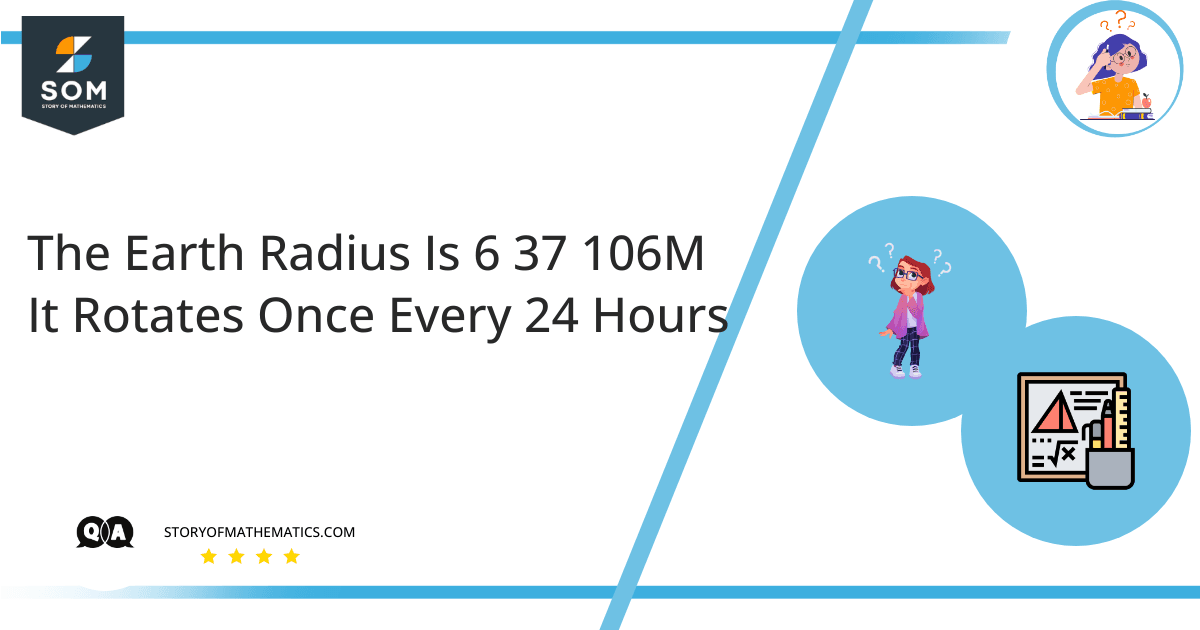
- Calculate the angular speed of the earth.
- Calculate the direction (positive or negative) of the angular velocity. Assume you are viewing from a point exactly above the north pole.
- Calculate the tangential speed of a point on the earth’s surface located on the equator.
- Calculate the tangential speed of a point on the earth’s surface located halfway between the pole and the equator.
The aim of the question is to understand the concept of angular and tangential speeds of a rotating body and the points on its surface, respectively.
If $\omega$ is the angular speed and $T$ is the time period of rotation, the angular speed is defined by the following formula:
\[\omega = \frac{2\pi}{T}\]
If the radius $r$ of the rotation of a point around the axis of rotation, then the tangential speed $v$ is defined by the following formula:
\[v = r \omega\]
Expert Answer
Part (a): Calculate the angular speed of the earth.
If $\omega$ is the angular speed and $T$ is the time period of rotation, then:
\[\omega = \frac{2\pi}{T}\]
For our case:
\[T = 24 \times 60 \times 60 \ s\]
So:
\[\omega = \frac{2\pi}{24\times 60 \times 60 \ s} = 7.27 \times 10^{-5} \ rad/s\]
Part (b): Calculate the direction (positive or negative) of the angular velocity. Assume you are viewing from a point exactly above the north pole.
When viewed from a point exactly above the north pole, the earth rotates counter-clockwise, so the angular velocity is positive (following the right-hand convention).
Part (c): Calculate the tangential speed of a point on the earth’s surface located on the equator.
If the radius $r$ of the rigid body is known, then the tangential speed $v$ can be calculated using the formula:
\[v = r \omega\]
For our case:
\[ r = 6.37 \times 10^{6} m\]
And:
\[ \omega = 7.27 \times 10^{-5} rad/s\]
So:
\[v = ( 6.37 \times 10^{6} m)(7.27 \times 10^{-5} rad/s)\]
\[v = 463.1 m/s\]
Part(d): Calculate the tangential speed of a point on the earth’s surface located halfway between the pole and the equator.
A point on the earth’s surface located halfway between the pole and the equator rotates in a circle of radius given by the following formula:
\[\boldsymbol{r’ = \sqrt{3} r }\]
\[r’ = \sqrt{3} (6.37 \times 10^{6} m) \]
Where $r$ is the radius of the earth. Using the tangential speed formula:
\[v = \sqrt{3} ( 6.37 \times 10^{6} m)(7.27 \times 10^{-5} rad/s)\]
\[v = 802.11 m/s\]
Numerical Result
Part (a): $\omega = 7.27 \times 10^{-5} \ rad/s$
Part (b): Positive
Part (c): $v = 463.1 m/s$
Part (d): $v = 802.11 m/s$
Example
The radius of the Moon is $1.73 \times 10^{6} m$
– Calculate the angular speed of the moon.
– Calculate the tangential speed of a point on the moon’s surface located midway between the poles.
Part (a): One day on Moon is equal to:
\[T = 27.3 \times 24 \times 60 \times 60 \ s\]
So:
\[\omega = \frac{2\pi}{T} = \frac{2\pi}{27.3 \times 24 \times 60 \times 60 \ s}\]
\[\boldsymbol{\omega = 2.7 \times 10^{-6} \ rad/s}\]
Part (b): Tangential speed on the given point is:
\[v = r \omega\]
\[v = ( 1.73 \times 10^{6} m)(2.7 \times 10^{-6} \ rad/s)\]
\[ \boldsymbol{v = 4.67 m/s}\]
